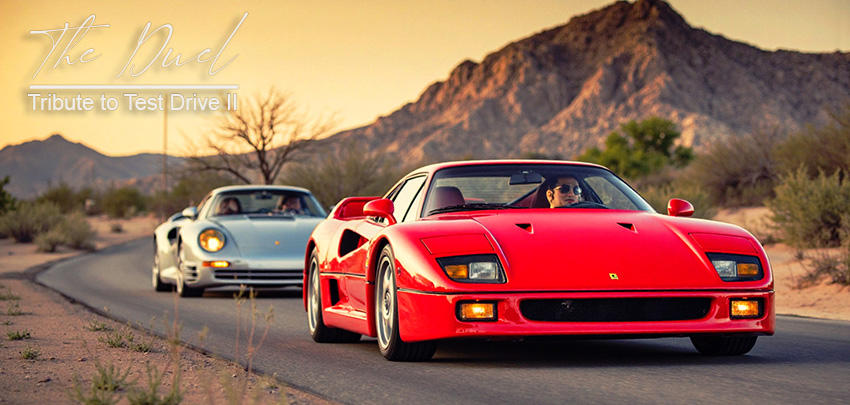For a certain breed of kid in the late 1980s, a bedroom wall was a sacred gallery. Mine was dominated by a single, massive poster of a Ferrari F40, its primal, savage beauty a testament to pure, unadulterated speed. It was a paper monument to a horsepower dream, curated with Scotch tape and adolescent obsession. But the F40 had a rival, a technological titan I only knew from the glossy pages of car magazines left on the table at the hairdresser's. This was the Porsche 959, a vision of the future beamed back to our time. While the Ferrari was on my wall, the Porsche was the machine that captured my imagination, a silent counterpoint in a war waged across magazine spreads and my own daydreams.
I devoured car magazines, memorizing their specs as if they were holy scripture. The Porsche was the technocrat's masterpiece. Its 2.85-liter flat-six engine was a direct descendant of Porsche's Le Mans-winning race cars, but its genius was the world's first sequential twin-turbocharging system. I’d try to explain to my friends how, below 4,300 rpm, a single small turbo provided instant boost, eliminating lag, before a second, larger turbo kicked in for a ferocious top-end rush. Its 444 horsepower was harnessed by the most advanced drivetrain imaginable: the Porsche-Steuer Kupplung (PSK) all-wheel-drive system. It wasn't just 4WD; it was a digital brain that could dynamically shift power from a 40:60 rear bias to sending 80% to the rear wheels under hard acceleration, all while the active suspension automatically lowered the car at high speed to reduce drag. It was built from aluminum and Kevlar, with a floor pan made of Nomex, a material I knew was commonly used in the aerospace industry. The 959 wasn't just a car; it was a statement about the future.
My best friend was a devotee of the church of Maranello, he even owned a metal-made model of the F40. It was the last car personally approved by Enzo Ferrari, and it was a machine of glorious, analog purity, a direct counterpoint to the Porsche's complexity. Its heart was the Tipo F120A, a larger 2.9-liter, 90-degree V8 with twin IHI turbochargers and Behr intercoolers, churning out a staggering 471 horsepower and 426 lb-ft of torque. But the F40’s true magic was its fanatical devotion to lightness. It weighed a mere 1100 kg, thanks to body panels made from a composite of carbon fiber and Kevlar bonded to a tubular steel spaceframe. The interior was brutally spartan—no carpets, no sound system, no glove box, just the raw weave of composite materials. The doors were opened with a simple pull-cord. This was a car that famously became the first production vehicle to breach the mythical 200 mph barrier. It had no ABS, no power steering, no driver aids whatsoever. It was a pure, unfiltered extension of the driver's will.
The things we owned were just static images or small models, inhabitants of a world as distant as the moon. Then, a 5.25-inch floppy disk changed everything. It was a simple title, a challenge laid bare, and it didn't just let you look at the legends; it handed you the keys. Loading it up on the family PC was a ritual. The rudimentary, grating, and squirky sounds from the internal speaker were a small price to pay for the magic that followed. The game’s genius was its singular focus on this epic rivalry.
My heart belonged to the Porsche. Slipping into its virtual cockpit was an exercise in sophisticated immersion. The developers had meticulously recreated the dashboard, for what was possible at the time, a feature that set their games apart. I could see the gauges, and most importantly, the functional rear-view mirror where the F40 would soon appear. The car felt stable, its advanced systems giving me the confidence to tackle the treacherous cliffside roads at speed.
My friend, of course, mostly chose the Ferrari. In his hands, the F40 was a twitchy, visceral beast. It demanded respect, but when he got it right, it was untouchable on the long, straight desert highways. Our afternoons became a series of digital duels. We weren't just racing against the clock; we were racing each other, weaving through civilian traffic. The constant threat of police patrols added a layer of delicious tension. Every car came equipped with a "fuzz buster" radar detector, and its escalating beeps became the frantic soundtrack to our risk-taking. Getting pulled over meant a time penalty; crashing into a cop was an instant game over.
That simple game was a "transitional fossil." It retained arcade elements like a lives system, but introduced complex mechanics that would form the DNA of the modern arcade racer. That core formula—licensed supercars, point-to-point races on public highways, civilian traffic, and strategic police chases—became the blueprint for an entire genre, a legacy most famously carried on by the Need for Speed series.
For us, though, it was simpler. It was freedom. It was the magical conduit that lifted the images off our bedroom walls and put us in the driver's seat. For a few precious hours after school, we weren't just kids in a suburban basement. We were flooring it on the Autobahn, clutching the wheel of a high-tech Porsche, with a friend's roaring Ferrari F40 filling our rear-view mirror. We didn't just play the game; we lived the duel.
Now, over thirty years later, I am using the experience I gained in creating LoRA’s to recreate a small memory of that time where we spent the afternoons racing each other. The idea came when I trained the LoRA for the F40, and this is a small homage to “The Duel - Test Drive II”.
